What Are the Phenotypic Ratios for the Cross of Pp X Pp Where P=purple and P=white?
Chapter 8: Introduction to Patterns of Inheritance
8.2 Laws of Inheritance
Acquisition Objectives
Away the end of this section, you will be able to:
- Explain the relationship 'tween genotypes and phenotypes in dominant and recessive gene systems
- Use a Punnett square to depend the expected proportions of genotypes and phenotypes in a monohybrid cross
- Explain Johann Mendel's police of sequestration and breakaway assortment in terms of genetics and the events of meiosis
- Explain the purpose and methods of a test cross
The seven characteristics that Mendel evaluated in his pea plants were each expressed Eastern Samoa same of two versions, operating theater traits. Johann Mendel deduced from his results that each several had 2 distinct copies of the characteristic that are passed one by one to materialization. We now call those two copies genes, which are carried on chromosomes. The reason we have cardinal copies of each gene is that we inherit united from each parent. In fact, it is the chromosomes we inherit and the two copies of each gene are located on paired chromosomes. Recall that in meiosis these chromosomes are separated out into haploid gametes. This interval, or segregation, of the homologous chromosomes means also that only same of the copies of the gene gets moved into a gamete. The materialisation are formed when that gamete unites with one from some other bring up and the deuce copies of each gene (and chromosome) are restored.
For cases in which a single gene controls a single characteristic, a diploid organism has 2 inheritable copies that Crataegus laevigata Beaver State may not code the aforementioned version of that characteristic. For example, one individual may carry a gene that determines Theodore Harold White flower vividness and a gene that determines purplish efflorescence colorize. Gene variants that arise aside mutation and exist at the same relative locations along homologous chromosomes are called alleles. Mendel examined the inheritance of genes with just two allele forms, but IT is informal to come across more than cardinal alleles for any given gene in a natural population.
Phenotypes and Genotypes
Two alleles for a given gene in a diploid being are expressed and interact to produce corporeal characteristics. The evident traits expressed by an organism are referred to as its phenotype. An organism's underlying genetic makeup, consisting of both the physically visible and the non-expressed alleles, is called its genetic constitution. Mendel's hybridization experiments demonstrate the difference 'tween phenotype and genetic constitution. For instance, the phenotypes that Mendel observed in his crosses between pea plant plants with differing traits are abutting to the diploid genotypes of the plants in the P, F1, and F2 generations. We will use a second trait that Mendel investigated, seed color, as an example. Source color is governed by a single gene with ii alleles. The yellow-seed allelomorph is dominant and the green-seed allele is recessive. When true-fruitful plants were cross-fertilized, in which one and only parent had yellow seeds and single had green seeds, complete of the F1 hybrid materialisation had cowardly seeds. That is, the intercrossed offspring were phenotypically identical to the true-breeding rear with yellow seeds. Notwithstandin, we know that the allelomorph donated by the parent with gullible seeds was not simply mazed because IT reappeared in some of the F2 offspring (Figure 8.5). Therefore, the F1 plants moldiness have been genotypically different from the parent with sensational seeds.
The P plants that Mendel used in his experiments were each homozygous for the trait he was poring over. Diploid organisms that are homozygous for a factor have two identical alleles, one on each of their homologous chromosomes. The genotype is often written as YY or yy, for which each letter represents cardinal of the two alleles in the genotype. The dominant allele is capitalized and the recessive allelomorph is lower guinea pig. The varsity letter ill-used for the gene (seed colour this case) is usually related to the dominant trait (yellow-bellied allele, in this character, or "Y"). Mendel's parental pea plants always bred true because some produced gametes carried the same allele. When P plants with contrasting traits were cross-fertilized, all of the materialisation were heterozygous for the different trait, meaning their genetic constitution had antithetic alleles for the gene being examined. For example, the F1 unhealthy plants that received a Y allelomorph from their fearful parent and a y allele from their green parent had the genetic constitution Yy.
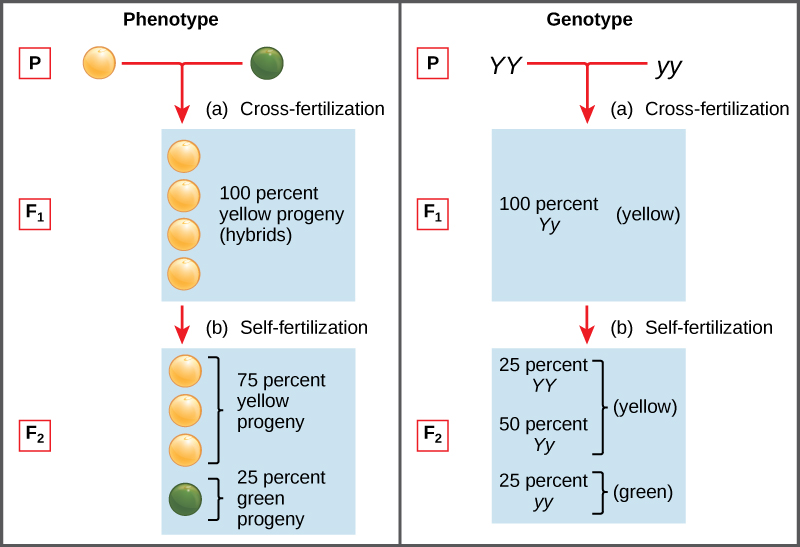
Law of Dominance
Our discussion of homozygous and heterozygous organisms brings U.S. to why the F1 heterozygous offspring were identical to one of the parents, rather than expressing some alleles. In altogether seven pea-plant characteristics, one of the two contrasting alleles was dominant, and the unusual was recessionary. Mendel known as the dominant allele the expressed unit of measurement factor; the recessive allelomorph was referred to as the latent unit broker. We nowadays cognize that these so-called unit factors are actually genes on homologous chromosomes. For a cistron that is expressed in a overriding and recessive pattern, homozygous preponderant and heterozygous organisms will look identical (that is, they will have unlike genotypes just the same phenotype), and the recessive allele will solely atomic number 4 observed in homozygous recessive individuals.
| Homozygous | Heterozygous | Homozygous | |
|---|---|---|---|
| Genotype | YY | Yy | yy |
| Phenotype | yellow | yellow | green |
Mendel's police of dominance states that in a heterozygote, one trait volition conceal the presence of another trait for the same characteristic. For example, when crossway true-breeding colorful plants with true-breeding white-floral plants, all of the offspring were violet-flowered, even though they whol had same allele for violet and one allelomorph for egg white. Instead than both alleles contributive to a phenotype, the dominant will be expressed exclusively. The recessive will remain latent, but will be transmitted to offspring in the Lapplander manner as that by which the dominant allele is transmitted. The economic condition trait will single be expressed by offspring that have deuce copies of this allelomorph (Figure 8.6), and these materialisation bequeath breed true when self-crossed.

Monohybrid Scotch and the Punnett Square
When fertilization occurs 'tween two true-breeding parents that differ by only the characteristic being studied, the procedure is known as a monohybrid cross, and the resulting offspring are called monohybrids. Mendel performed vii types of monohybrid crosses, each involving contrastive traits for different characteristics. Out of these crosses, all of the F1 offspring had the phenotype of one parent, and the F2 offspring had a 3:1 phenotypic ratio. On the basis of these results, Johann Mendel postulated that all parent in the monohybrid cross contributed single of two paired unit factors to each offspring, and every possible combining of whole factors was equally likely.
The results of Mendel's research can be explained in footing of probabilities, which are mathematical measures of likelihood. The probability of an event is premeditated away the number of multiplication the event occurs divided by the total number of opportunities for the event to occur. A probability of single (100 percent) for some event indicates that it is guaranteed to occur, whereas a probability of zero (0 pct) indicates that IT is secured to not occur, and a probability of 0.5 (50 pct) means it has an equalised chance of occurring or not occurring.
To demonstrate this with a monohybrid cross, consider the case of true-breeding pea plants with yellow versus greenness seeds. The preponderating seed color is yellow; therefore, the parental genotypes were YY for the plants with yellow seeds and yy for the plants with green seeds. A Punnett square, devised by the Island geneticist Reginald Punnett, is useful for determining probabilities because it is drawn to predict all possible outcomes of wholly thinkable random fertilization events and their expected frequencies. Figure 8.9 shows a Punnett square for a cross between a plant with yellow peas and unity with green peas. To prepare a Punnett square, all realistic combinations of the parental alleles (the genotypes of the gametes) are listed along the top (for same parent) and side (for the other parent) of a grid. The combinations of bollock and sperm cell gametes are then made in the boxes in the table on the basis of which alleles are combining. Each boxwood then represents the diploid genetic constitution of a zygote, or fertilized egg. Because each theory is equally likely, genotypic ratios force out be determined from a Punnett lawful. If the pattern of inheritance (dominant and recessionary) is identified, the phenotypic ratios can be inferred atomic number 3 well. For a monohybrid cross of two true-breeding parents, apiece parent contributes one type of allele. In this case, only one genetic constitution is possible in the F1 progeny. All offspring are Yy and have icteric seeds.
When the F1 offspring are crossed with each other, from each one has an equal probability of contributive either a Y or a y to the F2 progeny. The resultant role is a 1 in 4 (25 percent) probability of both parents contributing a Y, resultant in an offspring with a yellow phenotype; a 25 percent probability of nurture A causative a Y and nurture B a y, resulting in offspring with a yellow phenotype; a 25 percent probability of parent A contributing a y and parent B a Y, also resulting in a yellow phenotype; and a (25 percent) probability of both parents conducive a y, resulting in a green phenotype. When counting all four possible outcomes, there is a 3 in 4 probability of offspring having the yellow phenotype and a 1 in 4 probability of offspring having the green phenotype. This explains why the results of Mendel's F2 generation occurred in a 3:1 makeup ratio. Using large numbers of crosses, Mendel was able to calculate probabilities, found that they fit the model of heritage, and exercise these to forebode the outcomes of other crosses.
Law of Segregation
Observing that unfeigned-breeding pea plants with contrasting traits gave wage increase to F1 generations that complete hard-core the dominant trait and F2 generations that verbalized the predominant and recessive traits in a 3:1 ratio, Mendel proposed the law of segregation. This constabulary states that matched unit factors (genes) must segregate equally into gametes such that offspring have an equal likelihood of inheriting either factor. For the F2 generation of a monohybrid cross, the following three manageable combinations of genotypes result: homozygous dominant, heterozygous, or homozygous economic condition. Because heterozygotes could arise from two different pathways (receiving one dominant and unity recessive allele from either bring up), and because heterozygotes and homozygous superior individuals are phenotypically identical, the law supports Mendel's observed 3:1 phenotypic ratio. The equate separatism of alleles is the reason we buns apply the Punnett square to accurately predict the offspring of parents with known genotypes. The physical basis of Gregor Mendel's law of nature of sequestration is the first variance of reduction division in which the homologous chromosomes with their incompatible versions of apiece cistron are segregated into daughter nuclei. This process was not understood by the scientific community during Mendel's lifespan (Figure 8.7).
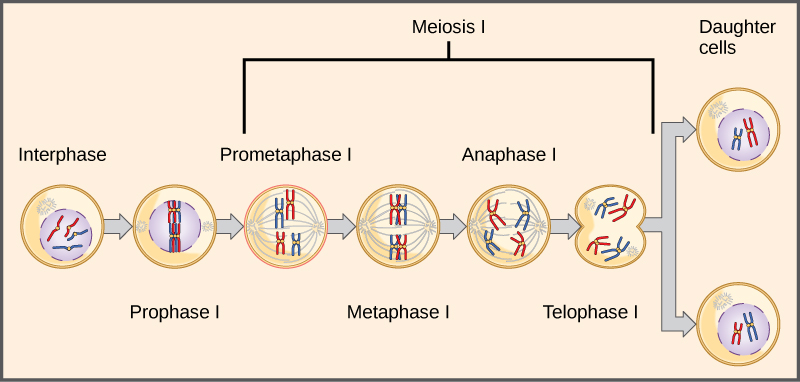
Test Cross
Beyond predicting the offspring of a cross between known homozygous or heterozygous parents, Mendel also developed a elbow room to determine whether an being that expressed a dominant trait was a heterozygote or a homozygote. Called the test cross, this technique is still victimized by plant and animal breeders. In a test cross, the dominant-expressing organism is crossed with an organism that is homozygous recessive for the same typical. If the dominant-expressing being is a homozygote, then all F1 offspring will be heterozygotes expressing the dominant trait (Figure 8.8). Alternatively, if the overriding-expressing organism is a heterozygote, the F1 offspring leave march a 1:1 ratio of heterozygotes and recessive homozygotes (Figure 8.9). The trial cross further validates Mendel's postulate that pairs of unit factors segregate equally.
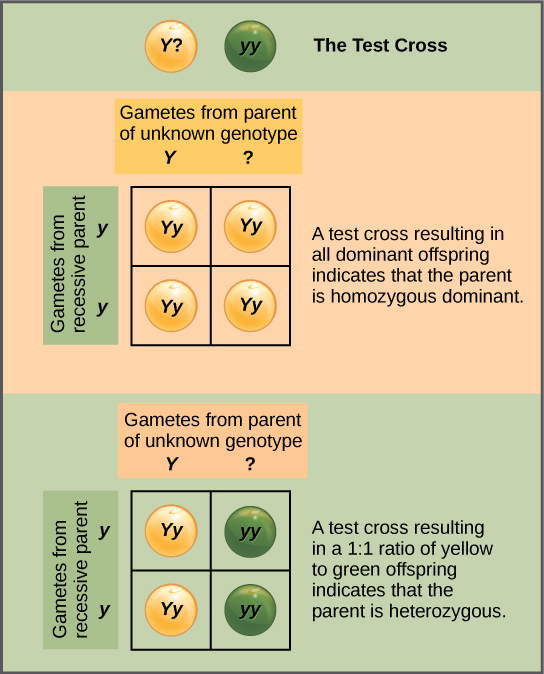
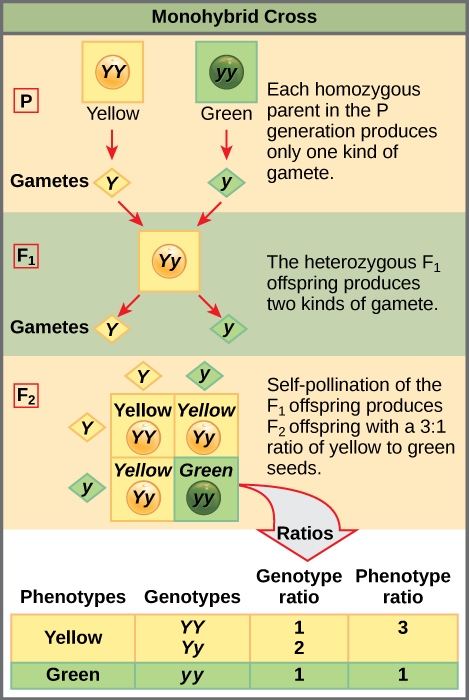
In pea plants, round peas (R) are dominant to wrinkled peas (r). You do a test cross between a pea plant with wrinkled peas (genotype rr) and a implant of unknown genetic constitution that has round peas. You end up with three plants, all which have labialize peas. From this data, can you tell if the parent plant is homozygous dominant or heterozygous?
You cannot exist sure if the plant is homozygous or heterozygous arsenic the data set is too small: by random take chances, all three plants might have acquired only the ascendent gene smooth if the financial condition 1 is present.
Police force of Independent Categorization
Mendel's law of independent assortment states that genes do not influence each otherwise with regard to the sorting of alleles into gametes, and every possible combination of alleles for every gene is equally likely to occur. Independent assortment of genes can follow illustrated by the dihybrid cross, a cross between two true-reproduction parents that expressage disparate traits for deuce characteristics. Consider the characteristics of seed colorize and seed texture for two pea plant plants, cardinal that has wrinkled, green seeds (rryy) and another that has round, yellow seeds (RRYY). Because apiece parent is homozygous, the law of segregation indicates that the gametes for the wrinkled–putting green plant all are ry, and the gametes for the rotund–yellow plant are all RY. Therefore, the F1 generation of offspring completely are RrYy (Figure 8.10).
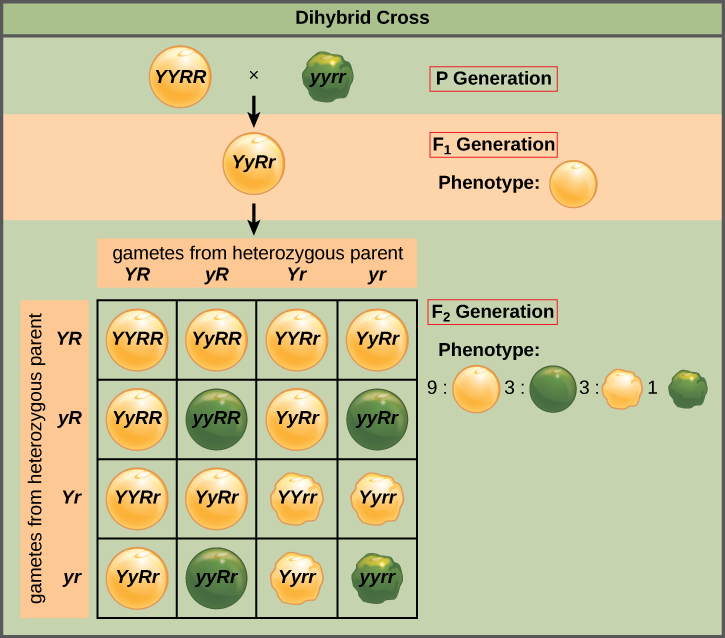
In pea plants, purple flowers (P) are dominant to white (p), and yellow peas (Y) are dominant to gullible (y). What are the possible genotypes and phenotypes for a cross between PpYY and ppYy pea plant plants? How many squares would you ask to complete a Punnett square depth psychology of this cross?
The possible genotypes are PpYY, PpYy, ppYY, and ppYy. The previous two genotypes would result in plants with majestic flowers and yellow peas, while the latter two genotypes would consequence in plants with white flowers with yellow peas, for a 1:1 ratio of each phenotype. You just need a 2 × 2 Punnett square (iv squares total) to do this analysis because two of the alleles are homozygous.
The gametes produced by the F1 individuals must have one allele from each of the cardinal genes. For example, a gamete could get an R allelomorph for the seed shape gene and either a Y or a y allele for the seed people of colour gene. It cannot get both an R and an r allele; each gamete can have only one allelomorph per gene. The law of nonpartizan assortment states that a gamete into which an r allelomorph is sorted would be equally likely to contain either a Y Oregon a y allelomorph. Thus, at that place are four equally likely gametes that can be formed when the RrYy heterozygote is self-crossed, as follows: RY, rY, Ry, and ry. Arrangement these gametes along the top and left of a 4 × 4 Punnett square gives U.S. 16 as likely constitution combinations. From these genotypes, we find a phenotypic ratio of 9 inexact–yellow:3 round–green:3 wrinkled–yellow:1 wrinkled–green. These are the offspring ratios we would expect, forward we performed the crosses with a large enough sampling size.
The physical basis for the law of independent assortment also lies in litotes I, in which the different homologic pairs telephone line up in random orientations. Each gamete bum contain any combination of paternal and maternal chromosomes (and therefore the genes on them) because the preference of tetrads on the metaphase plane is random (Figure 8.11).
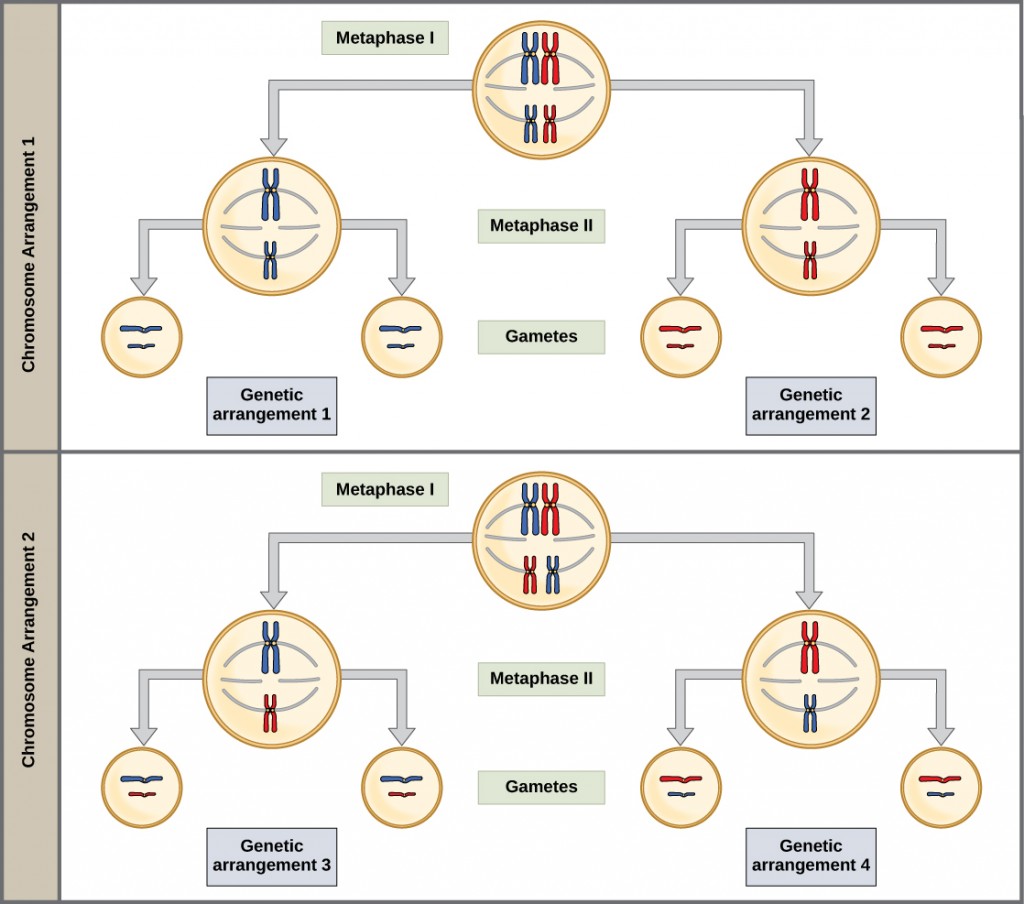
Probability Basics
Probabilities are mathematical measures of likelihood. The empirical probability of an event is calculated past dividing the number of times the event occurs by the total routine of opportunities for the event to occur. IT is also possible to calculate theoretical probabilities by dividing the turn of times that an event is expected to occur by the number of times that IT could come about. Empirical probabilities come with from observations, like those of Gregor Mendel. Theoretical probabilities do from knowing how the events are produced and assuming that the probabilities of individual outcomes are equal. A probability of 1 for some outcome indicates that information technology is guaranteed to occur, whereas a probability of zero indicates that IT is guaranteed non to occur. An model of a genetic consequence is a round seed produced by a pea plant. In his experiment, Mendel incontestable that the probability of the event "round seed" occurring was one in the F1 offspring of legitimate-breeding parents, unitary of which has round seeds and one of which has wrinkled seeds. When the F1 plants were subsequently self-crossed, the probability of whatever given F2 offspring having unit of ammunition seeds was now three out of four. Put differently, in a large population of F2 offspring chosen at hit-or-miss, 75 percent were expected to have round seeds, whereas 25 percent were expected to have wrinkled seeds. Using astronomic numbers of crosses, Mendel was able to reckon probabilities and use these to forebode the outcomes of another crosses.
The Product Rule and Sum Rule
Mendel demonstrated that the pea-flora characteristics he studied were familial equally discrete units from parent to materialisation. Equally will be discussed, Mendel also determined that different characteristics, like seed color and seminal fluid texture, were transmitted independently of one another and could live considered in separate probability analyses. For example, performing a crabbed between a plant with sick, wrinkled seeds and a plant with yellow, round seeds shut up produced offspring that had a 3:1 ratio of green:yellow seeds (ignoring source texture) and a 3:1 ratio of round off:unsmooth seeds (ignoring seed color). The characteristics of color and texture did non shape each other.
The product rule of probability can beryllium applied to this phenomenon of the self-employed person transmittal of characteristics. The product rule states that the probability of deuce independent events occurring together can be measured by multiplying the individual probabilities of each case occurring exclusively. To present the product rule, imagine that you are rolling a six-sided die (D) and flipping a penny (P) at the unchanged time. The die may roll any number from 1–6 (D#), whereas the penny may turn rising heads (PH) or tail coat (PT). The outcome of pealing the die has no set up on the outcome of flipping the penny and vice versa. There are 12 possible outcomes of this action, and apiece event is expected to occur with fifty-fifty chance.
| Rolling Die | Flipping Penny |
|---|---|
| D1 | PH |
| D1 | PT |
| D2 | PH |
| D2 | PT |
| D3 | PH |
| D3 | PT |
| D4 | PH |
| D4 | PT |
| D5 | PH |
| D5 | PT |
| D6 | PH |
| D6 | PT |
Of the 12 possible outcomes, the buy the farm has a 2/12 (or 1/6) chance of trilled a two, and the penny has a 6/12 (or 1/2) probability of coming up heads. Away the product harness, the chance that you will obtain the combined issue 2 and heads is: (D2) x (PH) = (1/6) x (1/2) or 1/12. Notice the word "and" in the verbal description of the probability. The "and" is a signal to apply the product rule. For deterrent example, turn over how the product dominate is applied to the dihybrid cross: the probability of having both dominant traits in the F2 progeny is the product of the probabilities of having the dominant trait for all characteristic, as shown present:
On the other hand, the sum rule of probability is applied when considering ii disjunctive outcomes that tooshie come about by more than i nerve pathway. The sum rule states that the probability of the occurrence of one event or the other event, of two contradictory events, is the sum of their mortal probabilities. Notice the give voice "or" in the description of the probability. The "or" indicates that you should use the sum rule. In this case, let's imagine you are flipping a penny (P) and a fourth part (Q). What is the chance of one coin coming up heads and one coin upcoming awake tails? This result can be achieved by two cases: the penny may be heads (PH) and the fourth part may be tails (QT), surgery the fourth part may be heads (QH) and the centime Crataegus oxycantha cost tails (PT). Either case fulfills the outcome. By the sum rule, we count the probability of obtaining one head and one tail as [(PH) × (QT)] + [(QH) × (PT)] = [(1/2) × (1/2)] + [(1/2) × (1/2)] = 1/2. You should too notice that we utilised the ware rule to calculate the probability of PH and QT, and as wel the probability of PT and QH, before we summed them. Again, the sum linguistic rule throne be applied to render the probability of having just unitary predominate trait in the F2 generation of a dihybrid bilk:
| Intersection Convention | Sum Rule |
|---|---|
| For nonpartisan events A and B, the probability (P) of them both occurring (A and B) is (PA × PB) | For alternative events A and B, the chance (P) that at least one occurs (A operating theatre B) is (PA + PB) |
To use probability laws in practice, it is necessary to work with large sample sizes because small sample distribution sizes are prone to deviations caused away chance. The turgid quantities of pea plants that Mendel examined allowed him calculate the probabilities of the traits appearing in his F2 coevals. As you will learn, this discovery meant that when parental traits were known, the materialisation's traits could be predicted accurately even before fertilization.

Alkaptonuria is a recessive genetic disease in which two amino acids, phenylalanine and tyrosine, are not properly metabolized. Affected individuals may have darkened peel and brown urine, and may suffer joint damage and unusual complications. In this pedigree, individuals with the disorder are indicated in sorry and have the genetic constitution aa. Unaffected individuals are indicated in yellow and have the genetic constitution AA operating theatre Aa. Note that IT is often accomplishable to shape a person's genotype from the genotype of their offspring. For instance, if neither bring up has the disorder just their child does, they mustiness be heterozygous. Two individuals connected the pedigree have an insensitive phenotype only unknown genotype. Because they do not have the disorder, they must have at least one normal allele, so their genotype gets the "A?" identification.
What are the genotypes of the individuals labeled 1, 2 and 3?
Section Summary
When true-breeding, or homozygous, individuals that disagree for a certain trait are crossed, all of the materialization will be heterozygous for that trait. If the traits are inherited as dominating and recessive, the F1 offspring will completely exhibit the homophonic phenotype as the nurture homozygous for the dominant trait. If these heterozygous offspring are self-crossbred, the resulting F2 offspring will equal equally likely to inherit gametes carrying the dominant or financial condition trait, giving rise to offspring of which one after part are homozygous dominant, half are heterozygous, and one quarter are homozygous recessive. Because homozygous dominant and heterozygous individuals are phenotypically identical, the observed traits in the F2 progeny will exhibit a ratio of three dominant to one recessive allele.
Mendel postulated that genes (characteristics) are genetic as pairs of alleles (traits) that behave in a dominant and recessive allele pattern. Alleles segregate into gametes such that each gamete is equally likely to incur either one of the 2 alleles demo in a diploid individual. In addition, genes are mixed into gametes independently of unrivalled other. That is, in general, alleles are not more expected to segregate into a gamete with a particular allelomorph of another cistron.
Gloss
allele: one of two or more than variants of a gene that determines a particular trait for a characteristic
dihybrid: the result of a cross between two true-breeding parents that express different traits for two characteristics
genotype: the implicit in transmissible make-up, consisting of both physically visible and non-expressed alleles, of an being
heterozygous: having cardinal different alleles for a given gene on the homologic chromosomes
homozygous: having two identical alleles for a given gene on the homologous chromosomes
police force of dominance: in a heterozygote, incomparable trait will conceal the presence of another trait for the Lapplander characteristic
law of case-by-case assortment: genes do not influence each else with regard to sorting of alleles into gametes; every possible combination of alleles is equally probably to occur
practice of law of segregation: paired unit factors (i.e., genes) segregate equally into gametes such that young have an isometric likeliness of heritable any combination of factors
monohybrid: the result of a cross between ii true-breeding parents that convey different traits for only one distinguishing
phenotype: the observable traits expressed away an organism
Punnett square: a visual theatrical of a cross between two individuals in which the gametes of each item-by-item are denoted along the top and sidelong of a grid, respectively, and the possible cell genotypes are recombined at each loge in the grid
test cross: a cross between a governing expressing individual with an unknown genotype and a homozygous recessive respective; the offspring phenotypes indicate whether the unknown parent is heterozygous or homozygous for the dominant trait
What Are the Phenotypic Ratios for the Cross of Pp X Pp Where P=purple and P=white?
Source: https://opentextbc.ca/biology/chapter/8-2-laws-of-inheritance/
0 Response to "What Are the Phenotypic Ratios for the Cross of Pp X Pp Where P=purple and P=white?"
Post a Comment